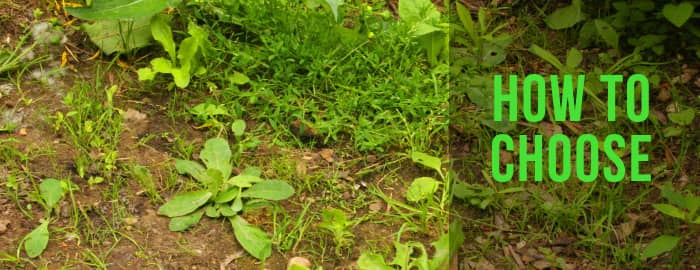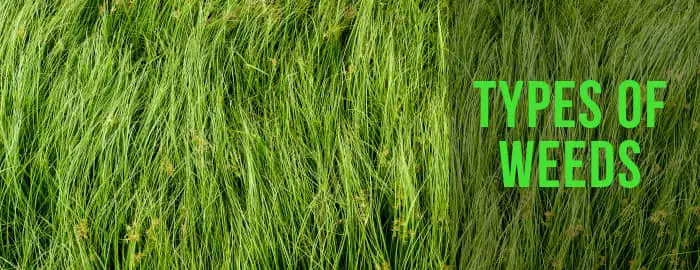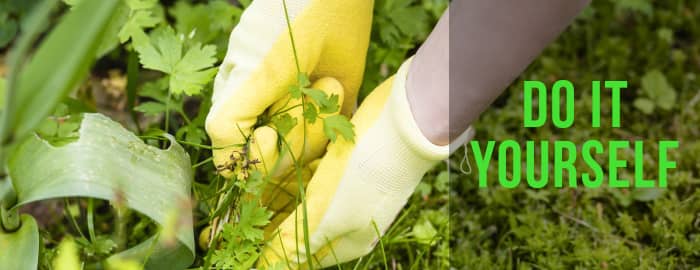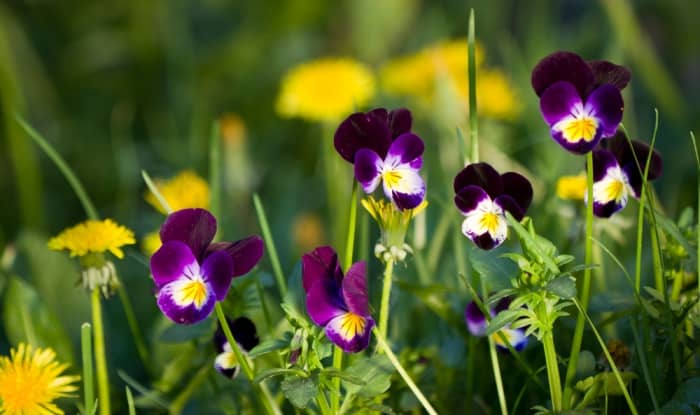Keeping flower beds weed free can be a pain.
But unfortunately, it’s a job you have to do.
If left, weeds can overtake them in a single growing season. Starving desirable flowers and shrubs of water and nutrients. Leaving them weak and affecting their growth.
Thankfully, there are good products available that make the job of controlling them an easier task.
We’ve researched over 20 of the top brands to find the best weed killer for flower beds.
These are our top picks:
All links lead to Amazon, where you can find more information & customer reviews.
5 Best Weed Killers For Flower Beds Reviewed
These are the products we recommend if you’re looking for a weed killer for flower beds. They include weed killers that can destroy existing weeds and ones that can prevent them growing in the first place:
Spectracide Weed & Grass Killer
Spectracide is a fast-acting weed killer that provides visible results in as little as 3 hours. With 24 hours often enough to get the job done.
It works quickly on contact with weeds and kills them to the root. So they don’t grow back again. But keeping your flower beds free from weeds sometimes takes more than one application. But because this is a concentrate it goes a long way when diluted.
With Spectracide being a non-selective weed killer, you will have to watch where you spray it. So if you’re using it near plants you want to keep it’s a good idea to protect them from the spray with a piece of cardboard.
If you do get any on your flowers or shrubs you should quickly try to wash it off before it does any real damage. For this reason, you should also make sure to use it on a day without wind so that you can be accurate with your spraying.
As well as around flowers, it’s also excellent for controlling weeds on driveways, patios, walkways, foundations, and along fence lines. You should avoid spraying it on vegetable gardens.
Not only is it one of the best weed killers, but it’s also a powerful insecticide that can control any insect problem you might have.
The product comes in 2 versions: a strong concentrated form that will require you to use a sprayer to safely use on affected areas. And a ready-to-use product that conveniently eliminates any weed infestation in your yard, without any messing around or mixing.
Spectracide offers a money-back guarantee if you’re not happy with the results.
Compare-N-Save Concentrate Grass and Weed Killer
This product contains a powerful 41% glyphosate solution. You can use it to spot treat around flower beds, vegetable gardens, trees, and shrubs.
And it’s also useful for killing weeds that are growing through driveways, pathways, and along fences.
Results are noticeable after a few days, but it can take up to 2 weeks for the weeds to die. This is because glyphosate is absorbed through the leaves and slowly attacks the plant as it’s carried down to the root.
And the good news is, that one application is often enough to do the job. With stubborn weeds sometimes needing a second dose. But they usually don’t come back quickly. So if you get rid of them in the spring you don’t have to use it again until the next year.
However, it doesn’t have residual activity, so it won’t completely stop new plants from growing in the soil. Which is useful to know if you’re planning on further planting, because some weed killers will prevent this.
Because Compare N Save is a non-selective weed killer you have to be very careful where you spray it. Any flowers or shrubs it touches will suffer damage and could die.
The advice we gave with Spectracide to use a piece of cardboard or plastic to protect desirable plants applies here as well. For this reason, it’s also best to use it on a day with no wind that can blow it off-target.
When diluted, the 1 gallon bottle of concentrate is enough to treat a 10,000 sq. ft. area.
Green Gobbler Vinegar Weed & Grass Killer
Did you know that vinegar can kill weeds? This natural and organic product uses a 20% concentration that’s a lot stronger than the normal 5% vinegar you buy for the table.
As well as being organic, it has a couple of big advantages over chemical products:
Firstly, it’s safer after use for both you and your pets. Although you still have to take care not to get it on exposed skin because acid burns!
And secondly, it’s very fast acting. Compared to most chemical weed killers that can take anywhere from several days to a few weeks to do the job, Green Gobbler will kill them in just a few hours. With complete disintegration within a day or two.
You still have to be careful not to spray it on plants that you want to keep. Vinegar is a non-selective weed killer that destroys plants on contact. But, it’s a bit more forgiving than systemic weed killers because it only affects the parts it touches and doesn’t kill them all the way to the root.
It comes ready to use in the bottle. So there’s no messing around with diluting it. But this can also be a disadvantage compared to chemical concentrates, as it doesn’t last as long. 1 gallon is enough for eliminating weeds over a 1,200 sq. ft. area.
Green Gobbler offer a 30 day no questions asked money-back guarantee if you don’t rate this product among the best weed killers.
Preen Garden Weed Preventer
Unlike the other weed killers on our recommended list, Preen is a pre-emergent weed killer. Which means you use it to stop weeds from growing in the soil. But it won’t kill weeds that are already there.
This makes it a great choice to use in flower beds. If you apply the granules to the soil early in the spring before weeds appear it prevents them from germinating for up to 3 months. And you can apply it again in the summer and fall to weed free areas to keep them at bay.
And you don’t have to worry about it harming your flowers. It’s specially formulated to be a safe weed killer when used around more than 200 species of flowers, vegetables, shrubs, and trees. But it’s not for use on your lawn.
Roundup Landscape Weed Preventer
This is a pre-emergent weed killer that stops weeds and grasses from germinating and growing. When used correctly it can prevent them for up to 6 months without harming desirable plants.
This means it’s good to use for flower bed weed control, and around trees and shrubs. But you can’t use it on lawns.
The active ingredient is pendimethalin, which inhibits the growth of shoots and roots. So make sure any plants you’re growing have a mature root system before applying Roundup to the soil.
It’s easy to use: you just sprinkle it onto the ground evenly using the built-in applicator and then water it in to activate it.
To get the best results it’s recommended to use it on weed-free ground in early spring before weed seeds germinate, and before you put down mulch.
Choosing The Right Weed Killer

Unfortunately, buying a weed killer isn’t as easy as choosing the first one on the shelf. Not if you want the best results.
You see, there are many different types, and knowing what they do will help you make the best choice to keep your flower beds weed-free. Here are some important things to consider before you buy:
Selectivity
Selective weed killers only target certain weeds and grasses. This makes them a safer option for use around ornamental flowers and shrubs. And you can often use them on lawns as well.
However, they’re often not quite as powerful as the next type:
Non-selective weed killers will destroy any plants that you spray them on. That means your flowers as well! You have to watch when using them to make sure that you’re only getting it on the weeds.
Emergence
Do you have weeds currently infesting your garden that you want to get rid of?
Or are you looking to stop them from appearing this year?
Depending on the problem you’ll need a different type of weed killer.
Pre-emergent weed killers will prevent weeds from growing when applied to weed-free ground. But, they won’t do anything for weeds that are already there. For that, you’ll need a post-emergent weed killer.
Contact or Systemic?
Systemic weed killers are taken inside the plant and then damage them internally. As the weed killer is carried around by the plant’s circulatory system it attacks from the inside, killing it all the way to the root. Glyphosate and 2,4-D are commonly used chemicals of this type.
Contact herbicides usually show results quickly when you make sure the target is fully wet. Whereas systemic (or translocated) herbicides can take 2-3 weeks to finally kill the plant. But as they kill it completely weeds are much slower to reappear. Whereas contact herbicides will see a quicker weed regrowth.
Persistence
If a herbicide continues to be effective in the soil, preventing weeds from germinating and growing then it’s persistent (or residual).
This can be very useful as you won’t have to keep on treating the area, meaning less work for you. But, you won’t be able to plant anything else until its effects have expired.
For this reason, they are often a good choice for using on driveways, paths, gravel areas, or patios—places where you don’t want anything to grow.
Non-persistent weed killers don’t prevent regrowth. And they’re often a better choice if you’re an active gardener
What Are The Common Types Of Weeds Around Flowers?

Knowing which type of weeds you have can help you to choose the right weed killer.
Let’s take a look at some of the ones you’re most likely to come across in flower gardens:
Bermudagrass
Bermudagrass is an aggressive perennial grass weed. It can be very difficult to control if you allow it to become established.
It’s sometimes mistaken for crabgrass because of the similar seed heads. And it spreads over barriers and through weed control fabric. Herbicides are usually needed to prevent its growth.
It has a coarse texture, above ground roots called stolons, and fine hairs where the leaf blade and leaf sheath meet.
Bermudagrass is also a valued turfgrass that’s often used on home lawns in the southern states.
Crabgrass
Crabgrass is a coarse annual weed that has many people pulling out their hair in frustration.
Its life cycle of germination, growth, and death all occur in the same year. But unfortunately, that’s not the end of it. Each crabgrass plant can produce around 150,000 seeds. And these seeds remain behind after it dies ready to germinate the next spring.
The best way of controlling it is to prevent the seeds from germinating using a pre-emergent product.
But you need to get the timing right. Crabgrass seeds start to germinate when the temperature in the soil gets to 55°F for several days in a row, usually in the spring. You can use a soil thermometer to keep track of the temperature and lay down your weed preventer at the right time.
If you can’t wait until next spring, then you can get herbicides that are formulated to target it.
Nutsedge
Nutsedge is a perennial sedge that’s notoriously difficult to eradicate.
It has a triangular stem that you can identify by feeling. The stem feels like it has 3 sides like a triangle.
At the end of the stem you usually find 3 leaves, and flowers that can be either yellow or purple. You often see yellow nutsedge growing in the middle of summer. Whereas purple nutsedge often appears later in the summer.
You need to use a herbicide to get rid of nutsedge. Why? Because pulling it out doesn’t remove its rhizomes and tubers and it will regrow.
Dandelion
The dandelion is a broadleaf weed that’s usually found growing in direct sunlight. Their fluffy seed puffs are distinctive. And these seeds are easily carried around your garden causing further growth in suitable areas.
Below ground, they have a taproot that can be difficult to remove by hand. And if you leave any of it behind then the plant will regrow.
Oxalis
Oxalis is a perennial weed that’s similar in appearance to clover. But it also has small yellow flowers when it blooms.
This low-growing plant is a stubborn and annoying weed that can take a lot of determination to manage. It can also take a lot of time, as you have to remove or kill every single bulbil.
You can dig oxalis out of your flower beds, but it will take many seasons for complete eradication. Instead, it can be a lot easier to control by spot spraying with a broadleaf weed herbicide.
Purslane
Purslane is an annual weed that grows close to the ground with tear-drop leaves, yellow star-shaped flowers, and a fleshy red stem.
This is a plant that you want to get to grips with early while it’s still young. Because once it matures and bears seeds it disperses them all around your garden, infesting many areas.
You can remove purslane yourself. But don’t leave any part of it in the soil or it will regrow. Herbicides can be very effective when the plant is still young and growing.
Spurge
Spurge is a low-growing weed that can cover your garden fast in the summer if not treated. It has lengthy brown stems that grow along the ground with leaves arranged at intervals opposite each other.
It has a single taproot that you can remove by hand. But wear gloves if you do because you have to handle them with care. If it breaks at the stem it releases a thick latex that can cause skin irritation and a rash.
What Other Things Can You Do?

Not interested in buying a weed killer?
In that case, here are some DIY methods that you can try:
Weeding By Hand
If you want to take matters into your own hands, then doing it yourself is a time-tested method to keep your flower beds free of weeds.
Be careful when pulling them up to make sure you get the whole plant including the roots. Anything that’s left in the ground will often lead to rapid regrowth.
The main downside to this method is that it can be back-breaking work and takes a long time. Depending on your physical fitness, this might not be a great choice. And the best weed killer might save you from over-exerting yourself.
Spread A Layer Of Mulch
As they say, prevention is better than cure. And spreading a 2-4 inch layer of mulch is an effective way to suppress weed growth.
It prevents light from finding its way to the soil. Which inhibits some seeds from germinating and denies those that do the energy needed to push their way through. But at the same time, it still allows water and nutrients to get into the soil.
But it won’t stop all weeds from appearing, and it won’t do much if you already have an existing weed problem.
Use A Vinegar Spray
Many of the natural weed killers available on the market are vinegar-based, and it can be a very effective treatment.
The commercially available products usually use a 20% acetic acid solution. Which is a lot stronger than the 5% solution that’s sold for use with food.
When using vinegar make sure to wet the entirety of the weed. Results are quick, with weeds starting to die within a day. But it doesn’t kill weeds permanently, they will grow back again.
Here’s a recipe you can use to make a DIY weed killer for flower beds. If you can, try and get 20% vinegar because you’ll see better results. The soap helps the mixture to stick to the leaves of the plant instead of rolling straight off.
Ingredients:
- Vinegar
- Salt
- Soap
Instructions:
- Pour 1 gallon of vinegar into an empty container
- Add 1 cup of salt to the vinegar
- Stir until the salt dissolves
- Add 1 tablespoon of soap and thoroughly mix together
- Pour the mixture into a spray bottle for use
Final Thoughts
You can control weeds by hand, but this can also be back-breaking work. And you’ll probably have to keep doing it again and again throughout the growing season to keep your flower beds clear.
But it’s important you keep on top of it. Because left unchecked they can have a negative effect on the growth and health of your flowers.
It’s a lot quicker and easier to use a weed killer. The type you need will depend on your problem and the type of weeds you are struggling with.
It’s ideal to prevent weeds from appearing in the first place if you can. And pre-emergent weed killers are useful for this. Then you can occasionally use a post-emergent weed killer if you need to spot treat any that appear. This significantly reduces your workload.
Most gardeners find the best weed killers highly effective. But remember when tackling existing weeds to take care where you spray if you use a non-selective weed killer. Or you’ll end up damaging the plants you want to keep as well.
Our recommended choice of the best weed killer for flower beds is Spectracide Weed & Grass Killer to deal with growing weeds, and Preen for prevention if you’re looking for a weed killer that won’t kill flowers.











